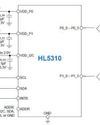
Welcome back to the world of Bluetooth. In my previous articles, I presented an overall introduction to Bluetooth and then explained the low-level layers of Bluetooth Low Energy (BLE). Last month we established a BLE connection between two devices ("No Blues with Bluetooth part 4 / Let's connect with BLE", Circuit Cellar 409, August 2024).
In this part, we will examine what information can be exchanged through such a connection and how the developer can make the BLE experience fully plug-and-play for the end user. Another protocol called the BLE application layer is required, often called by its nickname GATT.
BLE RECAP
Let's start with a small refresher on BLE. For simplicity, I stick with its basic version introduced in Bluetooth 4.0. Have a look again at the BLE protocol stack in Figure 1. As you probably remember, its physical layer uses 40 frequency channels in the ubiquitous 2.4GHz frequency band. Three of these channels (numbered 37, 38, and 39) are dedicated to BLE device discovery and connection establishment. This is done through the Generic Access Profile protocol (GAP, top right on the figure). A BLE peripheral broadcasts periodically an advertising frame to indicate its presence, as detailed in part 3 of this series.
هذه القصة مأخوذة من طبعة September 2024 من Circuit Cellar.
ابدأ النسخة التجريبية المجانية من Magzter GOLD لمدة 7 أيام للوصول إلى آلاف القصص المتميزة المنسقة وأكثر من 9,000 مجلة وصحيفة.
بالفعل مشترك ? تسجيل الدخول
هذه القصة مأخوذة من طبعة September 2024 من Circuit Cellar.
ابدأ النسخة التجريبية المجانية من Magzter GOLD لمدة 7 أيام للوصول إلى آلاف القصص المتميزة المنسقة وأكثر من 9,000 مجلة وصحيفة.
بالفعل مشترك? تسجيل الدخول

Renesas New RA8 Entry-Line MCU Groups Brings High Performance of Arm Cortex-M85 Processor to Cost-Sensitive Applications with Market-Leading CoreMark Performance
Renesas Electronics Corp., a premier supplier of advanced semiconductor solutions, introduced the RA8E1 and RA8E2 microcontroller (MCU) groups, extending the industry's most powerful series of MCUs.

Same Sky Expands AMT Absolute Encoder Line to Support Larger Shaft Sizes
Same Sky's Motion & Control Group announced the addition of a new series to its innovative AMT absolute encoder family designed to support larger motor shaft sizes from 9mm to 15.875mm (5/8 inch).

XP Power Launches New Series of Low-Profile, Baseplate-Cooled DC-DC Brick Converters
The RDF150 and RDF200 series are the latest additions to the RDF series of low-profile, baseplate-cooled, ultra-wide input DC-DC brick converters, which is already available in power outputs of 25W and 50W.

HMI Introduces Ultra-Low Voltage 12-bit GPIO Expander with Interrupt Output
HMI, a leading provider of advanced analog and power management technologies, announced the launch of its HL5310, an innovative ultra-low voltage 12-bit GPIO expander featuring interrupt output.

The Future of Embedded Chip Design Navigating the Chip Creation Space
Custom Silicon at Lower Cost, Reduced Development Time

The Long and Winding Road
From Maxim's RS-232 to WeMos ESP32: So Much to Do, So Little Time

Start to Finish Driving LCDs
Lumex Display with Microchip Driver for a TI MCU

Easing the Path for App Releases
Managed Development of React Native with Expo

Datasheet: Tiny Embedded Boards
Deliver Power, Performance, and Versatility in Meager Square Millimeters

Harvesting Ambient Energy
Hybrid Power Sources Cut IoT Battery Dependency